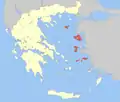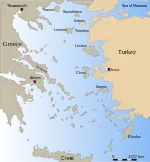Lesbos
Lesbos or Lesvos (/ˈlɛzbɒs/, also US: /ˈlɛzbəs, -boʊs/; Greek: Λέσβος, romanized: Lésvos [ˈlezvos]) is a Greek island located in the northeastern Aegean Sea, often called Mytilene (Μυτιλήνη) in Greece, after its capital.[2] It has an area of 1,633 km2 (631 sq mi)[3] with approximately 400 kilometres (249 miles) of coastline, making it the third largest island in Greece. It is separated from Asia Minor by the narrow Mytilini Strait and in late Palaeolithic/Mesolithic times[4] was joined to the Anatolian mainland before the end of the Last Glacial Period.
Lesbos
Λέσβος | |
|---|---|
Regional unit | |
| |
 April 2010 view of Mytilene | |
 Lesbos within the North Aegean | |
 Lesbos | |
| Coordinates: 39°12′36″N 26°16′48″E | |
| Country | Greece |
| Region | North Aegean |
| Capital | Mytilene |
| Area | |
| • Total | 1,632.8 km2 (630.4 sq mi) |
| Elevation | 967 m (3,173 ft) |
| Population (2021) | |
| • Total | 83.068 [1] |
| • Density | 51/km2 (130/sq mi) |
| Demonym | Lesbian |
| Time zone | UTC+2 (EET) |
| • Summer (DST) | UTC+3 (EEST) |
| Postal codes | 81x xx |
| Area codes | 225x0 |
Lesbos is also the name of a regional unit of the North Aegean region, within which Lesbos island is one of five governing islands. The others are Chios, Ikaria, Lemnos, and Samos. The North Aegean region governs nine inhabited islands: Lesbos, Chios, Psara, Oinousses, Ikaria, Fournoi Korseon, Lemnos, Agios Efstratios and Samos. The capital of the North Aegean Region is Mytilene. The population of Lesbos, which sometimes is called the Island of the Poets,[5] is 83.068, a third of whom live in its capital, Mytilene, in the southeastern part of the island. The remaining population is distributed in small towns and villages. The largest are Plomari, Kalloni, the Gera Villages, Agiassos, Eresos, and Molyvos (the ancient Mythimna).
According to later Greek writers, Mytilene was founded in the 11th century BC by the family Penthilidae, who arrived from Thessaly and ruled the city-state until a popular revolt (590–580 BC) led by Pittacus of Mytilene ended their rule. In fact, the archaeological and linguistic record may indicate a late Iron Age arrival of Greek settlers although references in Late Bronze Age Hittite archives indicate a likely Greek presence then. The name Mytilene itself seems to be of Hittite origin. According to Homer's Iliad, Lesbos was part of the kingdom of Priam, which was based in Anatolia. Much work remains to be done to determine just what happened and when. In the Middle Ages, it was under Byzantine and then Genoese rule. Lesbos was conquered by the Ottoman Empire in 1462. The Ottomans then ruled the island until the First Balkan War in 1912, when it became part of the Kingdom of Greece.
The island is widely known as the home of the ancient Greek poet Sappho, from whose association with homosexuality the word lesbian derives its modern meaning.
Etymology
The name is from Ancient Greek Λέσβος (Lésbos, 'forested, woody'), possibly a Hittite borrowing, as the original Hittite name for the island was Lazpa. An older name for the island that was maintained in Aeolic Greek was Ἴσσα (Íssa).
Tourism
Lesbos is known to be one of the Greek island touristic hotspots, especially during its tourism season of April, May, June and July.[6] Mytilene airport management recorded 47,379 tourists visiting Lesbos in its 2015 tourism season. The refugee crisis has since slowed down tourism to the island, with a 67.89% decrease rate from June 2015 to June 2016. 6,841 Europeans on 47 flights arrived in Lesbos during its 2016 tourism season, compared to July the previous year, which saw 18,373 Europeans fly to the island on 130 flights.[6] 94 cruise ships full of tourists arrived in Lesbos in 2011 and only one in 2018.[7] Of the refugee crisis' impact on tourism, Maria Dimitriou, a local shop owner from Mithymna, said, "2015 was a very good year for tourism and then, suddenly they started to arrive. The refugees began arriving in mid-July, when the hotels were full of tourists. There were refugees everywhere, lying down with all their trash. And after this, tourism stopped."[7]
In 2019, the head of the Lesbos chamber of commerce, Vangelis Mirsinias, told The Jakarta Post that the island's administration is trying to "woo back the tourists" and they "want to remind people of how beautiful" Lesbos is."[7] He advocated for the European Union to help in advertising and also said, "The economy is still paying the impact of the crisis. It will need time and money to change this image."[7] Lesbos is also a hotspot for Dutch tourists and one Dutch tourist said that tourism had halted because people "did not feel like seeing all this misery" of the refugees.[7] One local told the publication that residents had become "fed up" and "people are angry towards the government and towards Europe: they told us not to worry, the camps won't last. But it's still there", whilst another business owner explained that he had lost a third of his business and "blames all the negative media attention" for the lack of tourists.[7] The Jakarta Post also reported that tourists have increased in numbers in recent years, with 63,000 arriving in 2018.[7] The COVID-19 pandemic has also damaged the island's tourism industry.[8]
In English and most other European languages, including Greek, the term lesbian is commonly used to refer to homosexual women. This use of the term derives from the poems of Sappho, who was born in Lesbos and who wrote with powerful emotional content directed toward other women.[9] Due to this association, the town of Eresos, her birthplace, is visited frequently by LGBT tourists.[10]
Geography
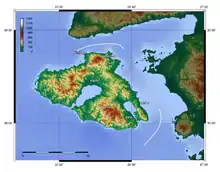
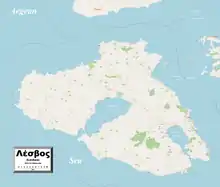


Lesbos lies in the far east of the Aegean sea, facing the Turkish coast (Gulf of Edremit) from the north and east; at the narrowest point, the strait is about 5.5 km (3.4 mi) wide. The shape of the island is roughly triangular, but it is deeply intruded by the gulfs of Kalloni, with an entry on the southern coast, and of Gera, in the southeast.[11]
The island is forested and mountainous with two large peaks, Mount Lepetymnos at 968 m (3,176 ft) and Mount Olympus at 967 m (3,173 ft) (not to be confused with Mount Olympus in Thessaly on the Greek mainland), dominating its northern and central sections.[12] The island's volcanic origin is manifested in several hot springs and the two gulfs.
Lesbos is verdant, aptly named Emerald Island, with a greater variety of flora than expected for the island's size. Eleven million olive trees cover 40% of the island together with other fruit trees. Forests of Mediterranean pines, chestnut trees and some oaks occupy 20%, and the remainder is scrub, grassland or urban.
Climate
The island has a hot-summer Mediterranean climate (Csa in the Köppen climate classification). The mean annual temperature is 18 °C (64 °F), and the mean annual rainfall is 750 mm (30 in). Its exceptional sunshine makes it one of the sunniest islands in the Aegean Sea. Snow and very low temperatures are rare.
| Climate data for Mytilene (1955-2010 averages) | |||||||||||||
|---|---|---|---|---|---|---|---|---|---|---|---|---|---|
| Month | Jan | Feb | Mar | Apr | May | Jun | Jul | Aug | Sep | Oct | Nov | Dec | Year |
| Record high °C (°F) | 20.2 (68.4) |
21.3 (70.3) |
28.0 (82.4) |
31.0 (87.8) |
35.0 (95.0) |
40.0 (104.0) |
39.5 (103.1) |
38.2 (100.8) |
36.2 (97.2) |
30.8 (87.4) |
27.0 (80.6) |
22.5 (72.5) |
40.0 (104.0) |
| Average high °C (°F) | 12.2 (54.0) |
12.8 (55.0) |
15 (59) |
19.3 (66.7) |
24.3 (75.7) |
28.9 (84.0) |
31 (88) |
30.8 (87.4) |
27 (81) |
22 (72) |
17.4 (63.3) |
13.9 (57.0) |
20.9 (69.6) |
| Daily mean °C (°F) | 9.5 (49.1) |
9.9 (49.8) |
11.6 (52.9) |
15.6 (60.1) |
20.2 (68.4) |
24.7 (76.5) |
26.6 (79.9) |
26.1 (79.0) |
22.9 (73.2) |
18.5 (65.3) |
14.3 (57.7) |
11.3 (52.3) |
17.6 (63.7) |
| Average low °C (°F) | 6.8 (44.2) |
7.0 (44.6) |
8.2 (46.8) |
11.4 (52.5) |
15.3 (59.5) |
19.6 (67.3) |
22 (72) |
21.7 (71.1) |
18.6 (65.5) |
15 (59) |
11.4 (52.5) |
8.7 (47.7) |
13.7 (56.7) |
| Record low °C (°F) | −4.4 (24.1) |
−3 (27) |
−1.2 (29.8) |
4.0 (39.2) |
8.4 (47.1) |
11.0 (51.8) |
15.8 (60.4) |
16.3 (61.3) |
10.9 (51.6) |
5.2 (41.4) |
1.4 (34.5) |
−1.4 (29.5) |
−4.4 (24.1) |
| Average precipitation mm (inches) | 111 (4.4) |
96.2 (3.79) |
70.1 (2.76) |
44.8 (1.76) |
19.8 (0.78) |
6.4 (0.25) |
2 (0.1) |
2.7 (0.11) |
12.4 (0.49) |
43.9 (1.73) |
97.1 (3.82) |
138.7 (5.46) |
670.6 (26.40) |
| Average precipitation days (≥ 1.0 mm) | 9.0 | 8.1 | 6.5 | 4.8 | 2.7 | 0.8 | 0.4 | 0.4 | 1.3 | 3.3 | 6.8 | 10.0 | 54.1 |
| Average relative humidity (%) | 71.0 | 69.8 | 57.5 | 63.9 | 62.6 | 57.3 | 56.0 | 57.4 | 59.5 | 66.1 | 71.0 | 72.0 | 64.5 |
| Source 1: Hellenic National Meteorological Service[13] | |||||||||||||
| Source 2: NOAA[14] | |||||||||||||
Geology

The entire territory of Lesbos is "Lesvos Geopark", which is a member of the European Geoparks Network (since 2000) and Global Geoparks Network (since 2004) on account of its outstanding geological heritage, educational programs and projects, and promotion of geotourism.[15]
This geopark was enlarged from former "Lesvos Petrified Forest Geopark". Lesbos contains one of the few known petrified forests, called Petrified forest of Lesbos, and it has been declared a Protected Natural Monument. Fossilised plants have been found in many localities on the western part of the island. The fossilised forest was formed during the Late Oligocene to Lower–Middle Miocene, as determined by the intense volcanic activity in the area. Neogene volcanic rocks dominate the central and western part of the island, comprising andesites, dacites and rhyolites, ignimbrite, pyroclastics, tuffs, and volcanic ash. The products of the volcanic activity covered the vegetation of the area and the fossilization process took place during favourable conditions. The fossilized plants are silicified remnants of a sub-tropical forest that existed on the northwest part of the island 20–15 million years ago.
History


According to Classical Greek mythology, Lesbos was the patron god of the island. Macareus of Rhodes was reputedly the first king whose many daughters bequeathed their names to some of the present larger towns. In Classical myth his sister, Canace, was killed to have him made king. The place names with female origins are claimed by some to be much earlier settlements named after local goddesses, who were replaced by gods; however, there is little evidence to support this. Homer refers to the island as "Macaros edos", the seat of Macar. Hittite records from the Late Bronze Age name the island Lazpa and must have considered its population significant enough to allow the Hittites to "borrow their gods" (presumably idols) to cure their king when the local gods were not forthcoming. It is believed that emigrants from mainland Greece, mainly from Thessaly, entered the island in the Late Bronze Age and bequeathed it with the Aeolic dialect of the Greek language, whose written form survives in the poems of Sappho, amongst others.

The abundant grey pottery ware found on the island and the worship of Cybele, the great mother-goddess of Anatolia, suggest the cultural continuity of the population from Neolithic times. When the Persian king Cyrus the Great defeated Croesus (546 BC) the Ionic Greek cities of Anatolia and the adjacent islands became Persian subjects and remained such until the Persians were defeated by the Greeks at the Battle of Salamis (480 BC). The island was governed by an oligarchy in archaic times, followed by quasi-democracy in classical times. For a short period it was a member of the Athenian confederacy, its apostasy from which is recounted by Thucydides in the Mytilenian Debate, in Book III of his History of the Peloponnesian War. In Hellenistic times, the island belonged to various Successor kingdoms until 79 BC when it passed into Roman hands.

During the Middle Ages it belonged to the Byzantine Empire. In 802, the Byzantine Empress Irene was exiled to Lesbos after her deposition, and died there.[17] The island served as a gathering base for the fleet of the rebel Thomas the Slav in the early 820s.[17]
In the 10th century, it was part of the theme of the Aegean Sea, while in the late 11th century it formed a dioikesis under a kourator in Mytilene.[17] In the 1090s, the island was briefly occupied by the Seljuk Turkish emir Çaka Bey, but he was unable to capture Methymna, which resisted throughout.[17] In the 12th century, the island became a frequent target for plundering raids by the Republic of Venice.[17]


After the Fourth Crusade (1202–1204) the island passed to the Latin Empire, but was reconquered by the Empire of Nicaea sometime after 1224.[17] In 1354, it was granted as a fief to the Genoese Francesco I Gattilusio, whose family ruled Lesbos until it was conquered by the Ottoman Turks in 1462.[17] It remained under Turkish rule, named مدللى (Midilli) in Turkish, until 1912 when it was taken by Greek forces during the First Balkan War.
The cities of Mytilene and Methymna have been bishoprics since the 5th century. By the early 10th century, Mytilene had been raised to the status of a metropolitan see. Methymna achieved the same by the 12th century.[17]

The oldest artifacts found on the island may date to the late Paleolithic period.[18] Important archaeological sites on the island are the Neolithic cave of Kagiani, probably a refuge for shepherds, the Neolithic settlement of Chalakies, and the extensive habitation of Thermi (3000–1000 BC). The largest habitation is found in Lisvori (2800–1900 BC) part of which is submerged in shallow coastal waters. There are also several archaic, classical Greek and Roman remains. Vitruvius called the ancient city of Mytilene "magnificent and of good taste". Remnants of its medieval history are three impressive castles.
Lesbos is the birthplace of several famous people. In archaic times, Arion developed the type of poem called dithyramb, the progenitor of tragedy, and Terpander invented the seven note musical scale for the lyre. Two of the nine lyric poets in the Ancient Greek canon, Alcaeus and Sappho, were from Lesbos. Phanias wrote history. The seminal artistic creativity of those times brings to mind the myth of Orpheus to whom Apollo gave a lyre and the Muses taught to play and sing. When Orpheus incurred the wrath of the god Dionysus he was dismembered by the Maenads and of his body parts his head and his lyre found their way to Lesbos where they have "remained" ever since. Pittacus was one of the Seven Sages of Greece. In classical times Hellanicus advanced historiography, Theophrastus, the father of botany, succeeded Aristotle as the head of the Lyceum. Aristotle and Epicurus lived there for some time, and it is there that Aristotle began systematic zoological investigations.[19] In later times lived Theophanes, the historian of Pompey's campaigns, Longus wrote the famous novel Daphnis and Chloe, and much later the historian Doukas wrote the history of the early Ottoman Turks. In modern times the poet Odysseus Elytis, descendant of an old family of Lesbos, received the Nobel Prize.
.jpg.webp)
Landmarks
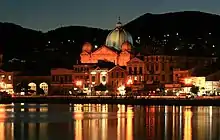
- Petrified forest of Lesbos
- Catholic Church of Theotokos, where part of the relics of Saint Valentine are kept
- Castle of Molyvos (Mithymna)
- Castle of Mytilene
- Castle of Sigri
- Church of Panagia Agiasos
- Monastery of Agios Raphael
- Monastery of Taxiarchis
- Roman Aqueduct of Lesbos (Mória)
- The Bridge at Kremasti
- Early Christian Basilica of Agios Andreas in Eressos
- Temple of Klopedi
- Christian Temple of Chalinados
- Ancient Sanctuary of Messa
- Acropolis of Ancient Pyrra
- Monastery of Ipsilou
- Monastery of Limonas
- Statue of Liberty (Mytilene)
- Ouzo Museum "The World of Ouzo"[20] in Plomari
- Barbayannis Ouzo Museum (Plomari)
- The Mosque in Parakila
- Catacomb of Mary Magdalene
- Sourlangas Leather Factory
Endangered sites
Twelve historic churches on the island were listed together on the 2008 World Monuments Fund's Watch List of the 100 Most Endangered Sites in the world. The churches range in date from the Early Christian Period to the 19th century. Exposure to the elements, outmoded conservation methods, and increased tourism are all threats to the structures. The following are the 12 churches:[21]
- Katholikon of Moni Perivolis
- Early Christian Basilica Agios Andreas Eressos
- Early Christian Basilica Afentelli Eressos
- Church of Agios Stephanos Mantamados
- Katholikon of Moni Taxiarchon Kato Tritos
- Katholikon of Moni Damandriou Polichnitos
- Metamorphosi Soteros Church in Papiana
- Church of Agios Georgios Anemotia
- Church of Agios Nikolaos Petra
- Monastery of Ipsilou
- Church of Agios Ioannis Kerami
- Church of Taxiarchon Vatousa
Administration
Lesbos is a separate regional unit of the North Aegean region, and since 2019 it consists of two municipalities: Mytilene and West Lesbos.[22] Between the 2011 Kallikratis government reform and 2019, there was one single municipality on the island: Lesbos, created out of the 13 former municipalities on the island. At the same reform, the regional unit Lesbos was created out of part of the former Lesbos Prefecture.[23]

.jpg.webp)

The municipality of Mytilene consists of the following municipal units (former municipalities):
- Agiasos (Αγιάσος)
- Evergetoulas (Ευεργέτουλας)
- Gera (Γέρα)
- Loutropoli Thermis (Λουτρόπολη Θερμής)
- Mytilene (Μυτιλήνη)
- Plomari (Πλωμάρι)
The municipality of West Lesbos consists of the following municipal units:
- Agia Paraskevi (Αγία Παρασκευή)
- Eresos-Antissa (Ερεσός-Άντισσα)
- Kalloni (Καλλονή)
- Mantamados (Μανταμάδος)
- Mithymna (Μήθυμνα)
- Petra (Πέτρα)
- Polichnitos (Πολίχνιτος)
Economy
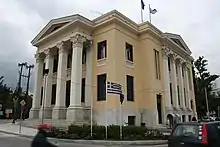

The economy of Lesbos is essentially agricultural in nature, with olive oil being the main source of income. Tourism in Mytilene, encouraged by its international airport and the coastal towns of Petra, Plomari, Molyvos and Eresos, contribute substantially to the economy of the island. Fishing and the manufacture of soap and ouzo, the Greek national liqueur, are the remaining sources of income.
Migrants
Due to its proximity to the Turkish mainland, Lesbos is one of the Greek islands most affected by the European migrant crisis that started in 2015. Refugees of the Syrian Civil War came to the island in multiple vessels every day.[29] As of June 2018, 8,000 refugees were trapped when a deal between Europe and Turkey removed their route to the continent in 2016. After that, living conditions deteriorated and the possibility for movement on to Europe dimmed. Moria Refugee Camp was the largest of the refugee camps and held twice as many people as it was designed to accommodate.[30] By May 2020, Moria had 17,421 refugees living there.[8]
On September 9, 2020, thousands of migrants fled from the overcrowded Moria camp, after a fire broke out. At least 25 firefighters, with 10 engines, were battling the flames both inside and outside the facility.[31] A smaller-scale facility, the Pikpa camp catered for a segment of the refugee population until its closure in October 2020, whereupon the occupants were transferred to the "old" Kara Tepe Refugee Camp.[32]
The Greek government maintains that the fires were started deliberately by migrants protesting that the camp had been put in lockdown due to a COVID-19 outbreak amongst the migrants in the camp. On September 16, 2020, four Afghan men were formally charged with arson for allegedly starting the fire.[33] Two other migrants, both aged 17, which is below the age of full adult criminal responsibility in Greece, were also allegedly involved in starting the fire, and were held in police detention on the mainland.[34]
After the closure of the Moria camp, a temporary facility was rapidly set up at Kara Tepe.[35] The Greek government announced in November 2020 that a new closed reception centre will be built in the Vastria area near Nees Kydonies, on the border between Mytilene and Western Lesbos, and will be completed by late 2021.[36]
Culture
Cuisine


Local specialities:
- Chachles, type of tarhana
- Kydonato, meat with quinces
- Revithato, meat with chickpeas
- Sardeles from Kalloni
- Ladotyri Mytilinis, cheese
- Selinato, meat with celery
- Sfougato, omelette
- Skafoudes, stuffed eggplants
- Sougania, stuffed onions
- Ouzo
- Platseda (dessert)
- Finikia (dessert)
- Amygdalota
- Retseli
In popular culture
- Films shot on the island include Daphnis and Chloe (1931) by Orestis Laskos, The tree under the sea (1985) by Philippe Muyl and One Love and the Other (1994) by Eva Bergman.
- Lesbos is depicted in Assassin's Creed Odyssey as the northeasternmost Aegean Island, the center of the island is where the player's character can encounter Medusa.[37]
Sports
The main football clubs in the island are Aiolikos F.C., Kalloni F.C. and Sappho Lesvou F.C.
Notable residents
.jpg.webp)
- Lesches (8th or 7th century BC), early poet
- Sappho (7th and 6th centuries BC), poet
- Terpander (7th century BC), poet and citharede
- Alcaeus of Mytilene (7th century BC), poet and politician
- Arion (7th century BC), poet
- Aristotle (384–322 BC), philosopher, was born in Chalkidike but lived for a time on the island.
- Theophrastus (370–285 BC), philosopher and botanist, successor to Aristotle
- Theophanes of Mytilene (1st century BC), ancient Greek historian
- Longus (2nd century AD), ancient Greek author
- Theoctiste of Lesbos (9th century), hermit saint
- Constantine IX Monomachos: Byzantine emperor (1042–1055), resident of Mytilene prior to accession.
- Christopher of Mytilene (11th century), poet
- Doukas, Byzantine historian
- Hayreddin Barbarossa (1470s–1546), Ottoman admiral
- Georgios Jakobides (1853–1932), painter
- Gregorios Bernardakis (1848–1925), classical philologist and palaeographer
- Demetrios Bernardakis, dramatist
- Theophilos Hatzimihail (c. 1870–1934), painter
- Georgios Emmanouil Kaldis (1875–1953) lawyer, journalist and politician
- Tériade (1889–1983), art critic, patron, and publisher
- Hermon di Giovanno (c. 1900–1968), painter
- Odysseas Elytis (1911–1996), poet, Nobel Prize in Literature 1979
- Tzeli Hadjidimitriou (b. 1962), photographer and writer
- Stratis Myrivilis (1890–1969), writer
- Elias Venezis, writer
- Ahmed Djemal (1872–1922), Ottoman commander, politician
- Kostas Kenteris, athlete (running, 200 meters), Gold Olympic medal Sydney 2000, World and European championship gold medal
- Alex Martinez, graffiti artist, illustrator, muralist
- Hüseyin Hilmi Pasha (1 April 1855 – 1922), Grand Vizier of the Ottoman Empire
- Tamburi Ali Efendi (1836–1902), Turkish classical composer
- Steffen Streich, ultra-endurance cyclist
Gallery
 "The burning of the Ottoman frigate at Eresos by Dimitrios Papanikolis" by Konstantinos Volanakis
"The burning of the Ottoman frigate at Eresos by Dimitrios Papanikolis" by Konstantinos Volanakis Ottoman flag in Mytilene in the last days of the Ottoman period
Ottoman flag in Mytilene in the last days of the Ottoman period Greek troops land at Mytilene, 1912
Greek troops land at Mytilene, 1912 Petra, Lesbos
Petra, Lesbos Extraction of the salt in Lesbos
Extraction of the salt in Lesbos Museum of industrial olive oil production, Agia Paraskevi
Museum of industrial olive oil production, Agia Paraskevi Limonas monastery
Limonas monastery_%CE%9B%CE%95%CE%A3%CE%92%CE%9F%CE%A3.jpg.webp) Taxiarchis Monastery
Taxiarchis Monastery Panagia Church in Agiasos
Panagia Church in Agiasos
See also
- Adobogiona – an inscription in Lesbos honors this Celtic princess
- Aeolic Greek
- Assos
- Lesbian rule – historically a flexible lead mason's rule associated with Lesbos
- Lesbian wine
- List of islands of Greece
- List of traditional Greek place names
- University of the Aegean
- Ancient regions of Anatolia
References
- "Elstat". statistics.gr.
- "Lesbos locals lose lesbian appeal". news.bbc.co.uk.
Greeks often refer to the island as Mytilene, after its capital.
- "Population & housing census 2001 (incl. area and average elevation)" (PDF) (in Greek). National Statistical Service of Greece. Archived from the original (PDF) on 2015-09-21.
- Harissis et al. 'A Palaeolithic site on Lesbos island, Greece'. "Αρχαιολογία και Τέχνες"(Archaeology & Arts) 2000;76:83–87, Article in Greek
- Λέσβος το νησί των ποιητών
- Zikakou, Ioanna (2016-07-03). "Tourist Arrivals on Greek Island of Lesvos Drop by 65%". Greek Reporter. Retrieved 2022-01-02.
- Valery, Chantal (2019-05-28). "Lesbos keen to woo back tourists after migration crisis". The Jakarta Post. Retrieved 2022-06-17.
- Valery, Chantal (2020-05-27). "Greece ready to welcome tourists as refugees stay locked down in Lesbos". The Guardian. Retrieved 2022-06-17.
- "lesbian". Dictionary.com Unabridged. Retrieved February 14, 2017.
- Carolyn, Bain; Clark, Michael; Hannigan, Des (2004). Greece. Lonely Planet. pp. 568–570. ISBN 1-74059-470-3.
- "Lesbos". Archived from the original on 2010-09-21.
- "The Petrified Forest of Lesvos, A Unique Natural Monument Recording the Evolutionary Process of Life on Earth". UNESCO Global Geoparks Network. Archived from the original on 2010-06-05.
- "HNMS". www.hnms.gr. Archived from the original on 2010-12-16. Retrieved 2011-04-03.
- "MITILINI Climate Normals 1961–1990". National Oceanic and Atmospheric Administration. Retrieved January 29, 2013.
- "Global Geoparks in Greece (UNESCO)" (PDF).
- "Sappho and Alcaeus". The Walters Art Museum.
- Gregory, Timothy E. (1991). "Lesbos". In Kazhdan, Alexander (ed.). The Oxford Dictionary of Byzantium. Oxford and New York: Oxford University Press. p. 1219. ISBN 0-19-504652-8.
- Harissis H.; Durand P.; Axiotis M.; Harissis T. (2000). "Traces of Paleolithic settlement in Lesbos". Archaiologia Kai Technes: 76:83–87 (article in Greek with English abstract).
- Harissis, H. 2017. 'The location of the euripus of Pyrrha in the works of Aristotle and Strabo'. Acta Classica 60.
- "The World of Ouzo (Ouzo Museum) - by Ouzo Plomari". theworldofouzo.gr.
- Churches Of Lesvos accessed July 31, 2014
- "Τροποποίηση του άρθρου 1 του ν. 3852/2010" [Amendment of Article 1 of l. 3852/2010] (in Greek). Government Gazette. p. 1164.
- "ΦΕΚ A 87/2010, Kallikratis reform law text" (in Greek). Government Gazette.
- "Aeolos".
- "Stonisi".
- "Emprosnet".
- "Lesvosnews".
- "Lesvospost".
- Tony Hemmings; Bill Neely (13 August 2015). "Migrants Crisis: Refugees Attempt to Reach Greek Island of Lesbos". NBCNews.com. Retrieved July 2, 2019.
- "After Fleeing War, Refugee Children Face Lasting Psychological Trauma". nationalgeographic.com. 20 June 2018. Retrieved July 2, 2019. (subscription)
- "Lesbos refugee camp fire forces thousands to evacuate". The Guardian. Retrieved 8 September 2020.
- The eviction of Pikpa Open Refugee Camp Lesvos solidarity December 2020 Newsletter, accessed 25 May 2021
- "Afghan Migrants Charged With Arson in Fires that Destroyed Lesbos Camp". The New York Times. 16 September 2020. Retrieved 26 September 2020.
- "Afghans Charged With Arson For Fire At Lesbos Camp". The Washington Post. 16 September 2020.
- "Lesvos reacts angrily to plans for new immigrant structure". greekcitytimes.com. 2 April 2021. Retrieved 24 May 2021.
- "Λέσβος / Ετοιμάζουν κλειστή δομή για τους πρόσφυγες στη Βάστρια". Αυγή (in Greek). 2020-11-30. Retrieved 2020-12-16.
- Loveridge 2018-10-09T10:50:17ZPS4, Sam. "How to find and beat the Assassin's Creed Odyssey Medusa". gamesradar. Retrieved 9 February 2019.
External links
- Official website (in Greek)
- Lesvos News (in Greek)
- Elstat (in Greek)
- "Prefecture of Lesvos". Maps. Hellenic Ministry of Culture. Archived from the original on April 8, 2007.
- Guide of Lesbos Island (in Greek, English, and Turkish)
- News of Mytilene and Lesvos Island (in Greek)
- "World's Monuments Watch List" (PDF). World Monuments Fund (WMF). 2008. Archived from the original on March 20, 2013.
{{cite web}}: CS1 maint: unfit URL (link)
